#Computer Architecture and Organization Online Tutor
Explore tagged Tumblr posts
Photo

Mathematics-2 Online Tutor Mathematics-2 Online Tutor Join The Best Online Tutor For B.Tech Subjects. B.Tech Online Tutor Available For Mathematics-2.
#Advanced Digital Signal Processing Online Tutor#Advanced Microcontrollers Online Tutor#Antennas and Wave Propagation Online Tutor#Basic Electrical Engineering Tutor#Basic Electronic Engineering#Basics of Electrical Engineering Online Tutor#Circuit Theory Online Tutor#CMOS Analog IC Design I Online Tutor#Cognitive Radio Communication Online Tutor#Communication Networks Online Tutor#Communication Theory Online Tutor#Computer Architecture and Organization Online Tutor#Computing Techniques Online Tutor#Control System Engineering Online Tutor#Data Structures and Object#Digital Communication Techniques Online Tutor#Digital Control Engineering Online Tutor#Digital Electronics and System Design Online Tutor#Digital Switching and Transmission Online Tutor#Digital VLSI Online Tutor#Discrete Time Signal Processing Online Tutor#Electromagnetic Fields and Waves Online Tutor#Electronic Circuits – I Online Tutor#Electronic Circuits – II Online Tutor#Electronic Devices Online Tutor#Embedded and Real-Time Systems Online Tutor#Engineering Chemistry Online Tutor#Engineering Graphics Online Tutor#Engineering Physics Online Tutor#Linear Algebra and Numerical Methods Online Tutor
0 notes
Text
Design Analysis Algorithm(DAA) Online Tutor
Design Analysis Algorithm(DAA) Online Tutor
Join The Best Online Tutor For B.Tech Subjects. B.Tech Online Tutor Available For BTech Computer Engineering. Call 9891500587 For Free Demo Class.
BTech All Subjects Online Tutor, Mathematics-1 Online Tutor, Engineering Physics Online Tutor, Engineering Chemistry Online Tutor, Discrete Mathematics Online Tutor, Computing Techniques Online Tutor,…
View On WordPress
#Advanced Digital Signal Processing Online Tutor#Advanced Microcontrollers Online Tutor#Antennas and Wave Propagation Online Tutor#Automata Theory Online Tutor Join The Best Online Tutor For B.Tech Subjects. B.Tech Online Tutor Available For BTech Computer Engineering. C#Basic Electrical Engineering Tutor#Basic Electronic Engineering#Basics of Electrical Engineering Online Tutor#Circuit Theory Online Tutor#CMOS Analog IC Design I Online Tutor#Cognitive Radio Communication Online Tutor#Communication Networks Online Tutor#Communication Theory Online Tutor#Computer Architecture and Organization Online Tutor#Computing Techniques Online Tutor#Control System Engineering Online Tutor#DAA Online Tutor#Data Structures and Object#Design Analysis Algorithm Online Tutor#Digital Communication Techniques Online Tutor#Digital Control Engineering Online Tutor#Digital Electronics and System Design Online Tutor#Digital Switching and Transmission Online Tutor#Digital VLSI Online Tutor#Discrete Mathematics Online Tutor#Discrete Time Signal Processing Online Tutor#Electromagnetic Fields and Waves Online Tutor#Electronic Circuits – I Online Tutor#Electronic Circuits – II Online Tutor#Electronic Devices Online Tutor#Embedded and Real-Time Systems Online Tutor
0 notes
Text
Top 10 Educational App Development Companies 2021-22
A comprehensive list of Educational App Development companies for your App Development project.

Interactive and personalized mLearning continues to expand in the predominant Global Education market, making it the most promising industry. This statement is made true by Statista, worldwide m-education spending in 2020 projected 37.8 billion US dollars. The rapid adoption of mEducation has revolutionized the learning and knowledge scales. Users can now access information anytime and anywhere.
The transition to mTextbooks has accelerated portable solutions over years. Publishing companies are now accepting and adapting to this transition. Schools are engaging in classroom learning platforms. Alternatively, mLearning is no longer restricted to K-12 students but has been widely used in employee training. Corporates are adopting ways to improve Employee Skill Development by exposing employees to learn-on-the-go experience. The on-the-go learning has transformed the attitude towards training and have improved course completion rates.
Many Top Educational App Development Organizations are already implementing advanced technologies like AI, Chatbots, Virtual Reality, Classroom and Mobile Gamification to deliver quality and premium education solutions to its users. However, the tech implementation may vary as per project requirements. So, If you are looking to outsource Educational App development, you will find a list below of carefully examined and handpicked top mEducation Development companies for your custom requirements:
Based on few parameters: Verified ratings on Clutch and Good Firms, Past work, Number of successful projects in the same genre, and the Development costs.
In addition to this, I have added Handy Tips for hiring among these shortlisted companies available at the bottom of the list.
Let's Take a Deep Look to the list of Top 10 Educational App Development Companies:
1. Digiryte

Digiryte is a multi award-winning Software development company known for its expertise in creating robust Web and Mobile based applications and systems. Digiryte delivers simple to complex cloud-based mobile applications with the help of developers who have expertise in a broad spectrum. They have served almost every industry from Healthcare to Education. They have excellent management and QA processes in place to ensure swift delivery.
Service Offerings: Artificial Intelligence, Machine Learning, Blockchain and IoT App Development
Pricing: $50 - $99 per hour
Location: The UK
Founded: 2015
2. IndiaInc Infotech

IndiaInc dwells on the top of Education App Development companies. IndiaInc delivers learning app solutions to Educational Institutes, Private Tutors, Corporates, Training centres. With extensive experience in the market, they have delivered projects for corporate trainings, classroom and online interactive learnings. They deliver apps with functionally rich features like Easy access to subject materials, Self assessment, consulting, assessment and Feedback. The experts of Indiaic have worked with corporate giants across the globe.
Service Offerings: Android, iOS and Progressive App Development, Cross-platform and Hybrid Development, App Automation, IoT Development
Pricing: $110-120 per hour
Location: USA, Australia, India
Founded: 1997
3. TechAhead

Founded in 2009, techahead is a 150 people company having a decade long proven track record in engineering innovative, robust, and scalable apps. From ideation to execution, innovation-led strategy, design, architecture, development, and maintenance services to focus on your business. TechAhead has noteworthy like Audi, American Express and The Times Groups. Also, Recognized among Top App Development companies by Clutch, GoodFirms, and AppFutura.
Service Offerings: Enterprise App Development, Mobile App Development, AI Development, IoT Development, Cloud Solutions.
Pricing: $50 - $99 per hour
Location: Canada
Founded: 2009
4. Deligence Technologies

Deligence Technologies is one of the leading Education Development Companies. They have developed and delivered successful offshore projects for Education industry with other domains. Their key client has over 1M active platform users.
With the size of 20-50, the specialized team has served user-centric apps with remarkable UI/UX design. They align themselves in the Vision of the project by doing extensive market research of the client's industry, so they deliver an app ahead of available industry resources.
Service Offerings: Android & iOS development, PWA development, IoT app development, Flutter App Development, Alexa Skill Development and Digital Media Marketing.
Pricing: $20-30 per hour
Location: India
Founded: 2014
5. QSS Technosoft:

QSS Technosoft (ISO 27001:2013 & CMMI Level 3 Certified) is an established IT services company that provides enterprise-level web and mobile app development solutions. They deliver projects for unique Business processes. The team has gained expertise in vast and trending technologies.
Service Offerings: Chatbot Development, Native App Development, Web App Development, Front-End Development
Pricing: $20 - 30 per hour
Location: USA, India
Founded: 2010
6. Code Brew Labs

Code Brew Labs is a reputed App Development company serving Education, Food, Healthcare, E-commerce, Taxi Hailing and Beauty domains. The team with extensive industry experience provides solutions that are not only profitable but help its clients stay strong in the competition. They have more than 300 Live Apps on both App Store and Google Play Store. Code Brew has been awarded and recognized among Fortune 500 companies. They have operations in India, USA, Dubai, Mexico and UK.
Service Offerings: Mobile and Web App Development, Software Development, MarketPlace Development, and Digital Marketing.
Pricing: $25 - $49 per hour
Location: Mexico
Founded: 2013
7. Konstant Infosolutions

Konstant Infosolutions serving innovative solutions to industries over a decade. They follow tailored methodology to develop client-centric highest quality projects. The App Development team constantly drive their efforts to deliver Next Gen App solutions while the Design team ensures the App look stunning, intuitive and drive maximum engagement. Award and Recognition: Ventures Clash Award, Bravo Zulu Awards 2017, Pope Francis Recognition.
Service Offerings: Android & iOS Development, Cross-platform Development, Wearable Development, IoT development,AI, VR/AR solutions, Cloud Computing, On demand and Chat solutions.
Pricing: <$25 per hour
Location: India
Founded: 2003
8. Fluper Limited

Fluper has successful, authentic track record of delivering 350+ Apps in the span of 7+ Years. Fluper has delivered Education projects to enhance conventional education techniques. 350+ Experts work on providing High-end services as per clients' needs. The company also provides some offers to its new clients. Fluper is a certified NASSCOM & IBM Partner, and Platinum Google App Developer.
There App Designs are as extraordinary as their own web design. Top Apps developed by Fluper have 50M+ users with high engagement rates. The team has delivered some remarkable apps for spectrum of Education domain.
Service Offerings: Android & iOS App Development, Web Development, Wearable Development, IoT Development, Cross Platform Development
Pricing: $31 - $50 per hour
Location: Dubai, UAE
Founded: 2013
9. The NineHertz

The NineHertz, Founded in 2008, is mobile application development, web development & web design company having a strong presence in USA, UK, Australia, Dubai, and India. The NineHertz has been delivering the best-suited solutions at a competitive cost across the world. The company has a team of certified full-time professionals, all equipped with a rich knowledge base on recent-most technologies. The NineHertz is recognized as industry leaders in ISO 9001:2008, Microsoft, NASSCOM, Amazon Web Services, and IGDA.
Service Offerings: Blockchain Development, Machine Learning, Iot Development, AI Development, Cloud Computing, Health & Wellness App Development, Education App Development, Mobile Game Development, and Web Development
Pricing: < $25 per hour
Location: US
Founded: 2008
10. X2Mobile

X2Mobile is among the top of Education App Development companies. They have specialized developers helping clients leverage the dynamic, fast-changing world of mobile app development and technology in education. X2 Mobile headquarters in Romania, but deliver great projects to companies across the EU and the US.
Service Offerings: Mobile App Development, Gamification UI/UX design
Pricing: $25 - $49 per hour
Location: Romania
Founded: 2013
Final Words:
All of the above mentioned mobile app development companies can help you build your app and determine its appearance and features and then make sure that it has all that makes it a hot cake. But going further, you know there are millions of apps that make to the app store, but only a few are loved by the audience at large.
Here are a few handy tips before you for one company:
Go beyond their client reviews. Ask for references. Talk to clients to learn about their experience working with the developer to check the authenticity of data. Ask as many questions as possible to clear your doubts and to inline your vision. Many clients report for expectation mismatch, So it is highly important to have clarity in thoughts and communication. Ask the Development team to create a documentation of their product understanding, to eliminate gaps prior to the on-boarding process. Talk to the delivery team to assure timely delivery of the project.
0 notes
Text
Get to know one of our newest School for Professional Studies program directors: Maria Weber, M.S.

What is your background and your journey to becoming the program director of SLU's Information Systems?
I have over 20 years of combined experience in the Information Technology Industry and Higher Education. I have worked with diverse engineering teams across the globe in many technologies, including network, wireless, cybersecurity, cloud computing, virtualization, information systems, GIS, and telecommunications. My journey included several positions in the IT industry demonstrating leadership roles directing complex projects in the second-largest US telecommunication provider. After 20 years of IT industry experience, I was blessed with a new career opportunity in Higher Education as a program director of the Master of Information Systems at SLU School of Professional Studies (SPS). As the program director, the core responsibilities are administration, teaching, scholarship, service, and professional activities. Among these responsibilities, teaching was not a new skill. During my 20 years of experience, I have been a mentor, tutor, trainer, technical writer, presenter, and lead of many junior engineers. At SLU, I teach undergrad and graduate courses for the Computer Science, Cybersecurity, and Information Systems programs at SPS and a grad course for the MBA program at SLU Business School.
What energizes you about teaching and working with adult students?
I enjoy inspiring adult students to learn, think, and excel by doing. Adult students look for topics that have current relevance and impact on their job or personal life. Therefore, I employ a transformative teaching approach in my courses using open-source enterprise software application tools in high demand in the IT industry. Students developed their critical thinking by reflecting on real-world problems in case scenarios, simulations, and role-playing exercises. Teaching the latest cutting-edge technologies allows students to succeed in any IT job.
Why should students consider a degree in Information Systems?
Digitalization, Globalization, and Technology are changing the way we do business. Employers are in need of IS enterprise leaders. Graduates of SLU's Master Information Systems Program will be prepared for advanced leadership roles by applying their analytical skills to determine organization needs, implement, manage, and improve systematic processes into agile information system applications, and drive business innovation by levering Information Technology.
What do you enjoy most about working at Saint Louis University?
I love to work at Saint Louis University because of their mission to pursue truth for the greater glory of God and service of others. I feel very fortunate to have this opportunity to work with a very supportive, helpful, and understanding team. The most rewarding part of my work is interacting with our students to see them grow and blossom during their careers.
Do you have any up-coming projects, research, or publications you are working on?
I serve on the Diversity Committee at SPS and Women's Commission at SLU. I will be serving as a judge for 2021 Arch Grants startup competition, a Global Startup Competition model, during the summer. I recently presented a publication in the 2021 Consortium for Computing Sciences in Colleges Central Plains Region's Conference. I will continue researching my areas of interest Information Systems, Cloud Computing, GIS, Digital Transformation, Enterprise Architecture, and Cybersecurity.
For information about our Information Systems program, visit slu.edu/online.
0 notes
Video
youtube

college paper help
About me
Buy University & College Papers Online 24
Buy University & College Papers Online 24 We don’t store accomplished papers on file, so there’s no approach to track your paper to our website. All of your ordered papers can only be accessed by way of your customer space. Proper formatting or following a quotation fashion is a must while writing a research paper or a term paper. Following the MLA or the APA format is a wise determination. However, be sure to are sticking to either MLA or APA, a combination between these two appears really shabby. Especially, when you are writing formal tutorial writing, the reader would search constructive info all alongside the writing. So, do you wish to know the key recipe of writing a remarkable time period paper that can help you get the ever-eluding A+? Just undergo the whole information, and you will get the gist. Think carefully about your matter and details in addition to evaluate the fabric you have found. Subdivide all the related materials into groups and then name each group. These names will serve as headings and subheadings in your outline. You don't need to unnecessarily blabber about something so long as you are talking about one thing related. Creating an overview prior to writing offers you a sense of management. That’s why we focus on the well timed delivery of all orders having an urgent deadline. Plus we deliver 60% of orders forward of schedule at no additional cost, so you can really matter on the quickest turnaround available in the market. Regardless of what kind of beginning you choose, the secret's to seize readers' consideration. The consequences of plagiarism in a student's paper. You can how much time it will take to complete the whole piece and which part would take extra time. At the same time, you would render a smoother studying expertise, and every little thing can be in some sort of chronological order. A time period paper has a set format, nevertheless it differs from course to course. For instance, a Computer Science course will have a special format of writing when compared to an Architecture course. You must ask your trainer about the way to outline a paper – she or he can information you one of the best. Another major distinction between them is the purpose. Ensure to fastidiously read your guidelines to completely perceive the prompt, then brainstorm over ideas in your essay's introduction. Some of the methods to begin your narrative essay could possibly be to use quotes from identified authors, anecdotes, questions, shocking assertion, attention-grabbing facts or by describing the setting. It will all the time help you keep centered and persist with the main points in your paper. However, a tutor, trainer, or professor might ask you to submit your working-time period paper outline earlier than you begin writing. He or she's going to check the methods that you are going to develop your thesis and can recommend some improvement areas. Your term paper outline is your reliable compass throughout the writing process. Here, you organize all of the points that you will focus on in your term paper.
0 notes
Text
How Technology is Changing the Future of Higher Education

This article is part of our latest Learning special report. We’re focusing on Generation Z, which is facing challenges from changing curriculums and new technology to financial aid gaps and homelessness.MANCHESTER, N.H. — Cruising to class in her driverless car, a student crams from notes projected on the inside of the windshield while she gestures with her hands to shape a 3-D holographic model of her architecture project.It looks like science fiction, an impression reinforced by the fact that it is being demonstrated in virtual reality in an ultramodern space with overstuffed pillows for seats. But this scenario is based on technology already in development.The setting is the Sandbox ColLABorative, the innovation arm of Southern New Hampshire University, on the fifth floor of a downtown building with panoramic views of the sprawling red brick mills that date from this city’s 19th-century industrial heyday.It is one of a small but growing number of places where experts are testing new ideas that will shape the future of a college education, using everything from blockchain networks to computer simulations to artificial intelligence, or A.I.Theirs is not a future of falling enrollment, financial challenges and closing campuses. It’s a brighter world in which students subscribe to rather than enroll in college, learn languages in virtual reality foreign streetscapes with avatars for conversation partners, have their questions answered day or night by A.I. teaching assistants and control their own digital transcripts that record every life achievement.The possibilities for advances such as these are vast. The structure of higher education as it is still largely practiced in America is as old as those Manchester mills, based on a calendar that dates from a time when students had to go home to help with the harvest, and divided into academic disciplines on physical campuses for 18- to 24-year-olds.Universities may be at the cutting edge of research into almost every other field, said Gordon Jones, founding dean of the Boise State University College of Innovation and Design. But when it comes to reconsidering the structure of their own, he said, “they’ve been very risk-averse.”Now, however, squeezed by the demands of employers and students — especially the up and coming Generation Z — and the need to attract new customers, some schools, such as Boise State and Southern New Hampshire University, are starting labs to come up with improvements to help people learn more effectively, match their skills with jobs and lower their costs.
College by Subscription
One of these would transform the way students pay for higher education. Instead of enrolling, for example, they might subscribe to college; for a monthly fee, they could take whatever courses they want, when they want, with long-term access to advising and career help.The Georgia Institute of Technology is one of the places mulling a subscription model, said Richard DeMillo, director of its Center for 21st Century Universities. It would include access to a worldwide network of mentors and advisers and “whatever someone needs to do to improve their professional situation or acquire a new skill or get feedback on how things are going.”Boise State is already piloting this concept. Its Passport to Education costs $425 a month for six credit hours or $525 for nine in either of two online bachelor’s degree programs. That’s 30 percent cheaper than the in-state, in-person tuition.Paying by the month encourages students to move faster through their educations, and most are projected to graduate in 18 months, Mr. Jones said. The subscription model has attracted 47 students so far, he said, with another 94 in the application process.However they pay for it, future students could find other drastic changes in the way their educations are delivered.
Your Teacher Is a Robot
Georgia Tech has been experimenting with a virtual teaching assistant named Jill Watson, built on the Jeopardy-winning IBM Watson supercomputer platform. This A.I. answers questions in a discussion forum alongside human teaching assistants; students often can’t distinguish among them, their professor says. More Jill Watsons could help students get over hurdles they encounter in large or online courses. The university is working next on developing virtual tutors, which it says could be viable in two to five years.S.N.H.U., in a collaboration with the education company Pearson, is testing A.I. grading. Barnes & Noble Education already has an A.I. writing tool called bartleby write, named for the clerk in the Herman Melville short story, that corrects grammar, punctuation and spelling, searches for plagiarism and helps create citations.At Arizona State University, A.I. is being used to watch for signs that A.S.U. Online students might be struggling, and to alert their academic advisers.“If we could catch early signals, we could go to them much earlier and say, ‘Hey you’re still in the window’ ” to pass, said Donna Kidwell, chief technology officer of the university’s digital teaching and learning lab, EdPlus.Another harbinger of things to come sits on a hillside near the Hudson River in upstate New York, where an immersion lab with 15-foot walls and a 360-degree projection system transports Rensselaer Polytechnic Institute language students to China, virtually.The students learn Mandarin Chinese by conversing with A.I. avatars that can recognize not only what they say but their gestures and expressions, all against a computer-generated backdrop of Chinese street markets, restaurants and other scenes.Julian Wong, a mechanical engineering major in the first group of students to go through the program, “thought it would be cheesy.” In fact, he said, “It’s definitely more engaging, because you’re actively involved with what’s going on.”Students in the immersion lab mastered Mandarin about twice as fast as their counterparts in conventional classrooms, said Shirley Ann Jackson, the president of Rensselaer.Dr. Jackson, a physicist, was not surprised. The students enrolling in college now “grew up in a digital environment,” she said. “Why not use that to actually engage them?”Slightly less sophisticated simulations are being used in schools of education, where trainee teachers practice coping with simulated schoolchildren. Engineering students at the University of Michigan use an augmented-reality track to test autonomous vehicles in simulated traffic.
A Transcript for Life
The way these kinds of learning get documented is also about to change. A race is underway to create a lifelong transcript.Most academic transcripts omit work or military histories, internships, apprenticeships and other relevant experience. And course names such as Biology 301 or Business 102 reveal little about what students have actually learned.“The learner, the learning provider and the employer all are speaking different languages that don’t interconnect,” said Michelle Weise, chief innovation officer at the Strada Institute for the Future of Work.A proposed solution: the “interoperable learning record,” or I.L.R. (proof that, even in the future, higher education will be rife with acronyms and jargon).The I.L.R. would list the specific skills that people have learned — customer service, say, or project management — as opposed to which courses they passed and majors they declared. And it would include other life experiences they accumulated.This “digital trail” would remain in the learner’s control to share with prospective employers and make it easier for a student to transfer academic credits earned at one institution to another.American universities, colleges and work force training programs are now awarding at least 738,428 unique credentials, according to a September analysis by a nonprofit organization called Credential Engine, which has taken on the task of translating these into a standardized registry of skills.Unlike transcripts, I.L.R.s could work in two directions. Not only could prospective employees use them to look for jobs requiring the skills they have; employers could comb through them to find prospective hires with the skills they need.“We’re trying to live inside this whole preindustrial design and figure out how we interface with technology to take it further,” said Ms. Kidwell of Arizona State. “Everybody is wrangling with trying to figure out which of these experiments are really going to work.”This story was produced in collaboration with The Hechinger Report, a nonprofit, independent news organization focused on inequality and innovation in education. Read the full article
#1technews#0financetechnology#0technologydrive#03technologysolutions#0dbtechnology#0gtechnology#1technologycourtpullenvale#1technologydr#1technologydrivemilpitasca95035#1technologydrivepeabodyma#1technologyplace#1technologyplacerocklandma#1technologywaynorwoodma#1/0technologycorp#2technologydrivestauntonva24401#2technologydrivewarrennj#2technologydrivewestboroughma01581#2technologyplace#2technologyplacemacquarieuniversity#2000stechnology#3technologybets#3technologydrivepeabodyma#3technologyltd#3technologywaynorwoodma#3dtechnologynews#3mtechnologynews#4technologycircuithallam#4technologycomponentsofcrm#4technologydrivelondonderrynh03053#4technologydrivepeabodyma01960
0 notes
Text
Best Android Training in Bangalore
Techmed Academy is the best mobile development training institute in Bangalore for the best Android training in Bangalore that offers high-quality training with affordable training course fees.
What is Android and Why Android? As the current world trends towards the latest, easy and flexible technologies, mobile application development is becoming popular and go to the field in the IT industry. Android is one of the newly emerging technologies which is derived from existing mobile app development and computing mechanisms on Android Operating Systems.
Android is ruling up to 80% of the current mobile market and fulfill all requirements of the end-users by its real-time applications and low time & money consuming factors such as ubiquitous (anywhere – anytime) access, ease-to-use, security, social networking, etc. Due to these highlights, count of the android users is gradually growing day by day. It has already beaten other technologies and conquered a separate place for it in the current IT environment.
What are the Major Outcomes of Our Android Training in Bangalore?
We are the best Android training institute in Bangalore, where you can obtain real-time, practical and live-classroom coaching from industrial experts. Techmed Academy is the Top Android institute in Bangalore offers high-quality training with affordable Android training fees in Bangalore. Our Android training course syllabus is designed by highly experienced professionals. Our tutors can guide you to clear the examinations on Android certification in Bangalore and our training program starts from the fundamentals of mobile computing until the advanced level of android application.
To proceed to the Android application development course, knowledge of key concepts like Java fundamentals and lifecycle of android services will be added advantage. With this Android course, enable yourself with the knowledge of Android architecture, layouts, and components. There are lots of job opportunities in Android, so go for it. This course will be suitable for freshers and working professionals who are good at codings and innovative logic.

Who Can Get Android Course with Certification Support in Bangalore? A person with basic knowledge of any other programming language will be helpful for you to learn Core Java and Android easily. As all our Android trainers are well-qualified mobile application developers, we provide you the best Android practical training in Bangalore along with the course.
Are You A Fresher Willing To Learn Android with Java Programming? We start from the basic Java programming basics, syntactical concepts, and mobile app development basics to make you strong in fundamentals.
Are You Core Java Developer Interested To Become An Android Developer? You can opt for Android training in Bangalore if you want to be proficient in Mobile application development technologies
Exclusive Benefits of Our Android Courses in Bangalore All our Android trainers at Techmed Academy are certified at the associate level and professional level in Android application developers. So, we will help you with the best Android certification training and exam preparation support.
According to the students’ convenience, we schedule classroom and online training with affordable Android training cost in Bangalore. So, comparing other centers, Techmed Academy is a top-class Android training center in Bangalore offering Android training in Bangalore with complete hands-on sessions and practical classes.
Affordable Android course fees in Bangalore
Weekdays and weekend Android classes in Bangalore
Android live project guidance in Bangalore
Job-oriented Android coaching programs in Bangalore with placements
Flexible Android class timings and class duration in Bangalore
Android certification course in Bangalore for Developers
Different modes of Android training: Classroom training, Online training, Corporate training, and Fast-track training.
Prepare Yourself to Find the Best Android Jobs and Placements in Bangalore Our Android course in Bangalore with placement assistance helps you to build your resume to make you a job-ready candidate at the end of the training. As most of the organizations are depending on application development, there is always a high demand for Android developers in the IT current market.
Especially for freshers/beginners who are passionate about programming and software development can go for this Android course to find the best Android job opportunities in Bangalore. We can find plenty of Android Jobs in Bangalore, for the experienced candidates who are good at mobile app development technologies. So, match your skillset soon with us.
Android Jobs and Skills Set Required
Android Developer Jobs in Bangalore – Core Java, OOPS, Android
Senior Mobile App Developer Jobs in Bangalore – Core Java, Android, Objective C, iOS, Windows
Application Developer Jobs in Bangalore – Core Java, Oracle DB, Android, Web Technologies
For more info:http://www.techmedacademy.com/android/Android_App_Development_Course.php
0 notes
Photo

Mathematics I Online Tutor Mathematics I Online Tutor Join The Best Online Tutor For B.Tech Subjects. B.Tech Online Tutor Available For Mathematics-I.
#Advanced Digital Signal Processing Online Tutor#Advanced Microcontrollers Online Tutor#Antennas and Wave Propagation Online Tutor#Basics of Electrical Engineering Online Tutor#Circuit Theory Online Tutor#CMOS Analog IC Design I Online Tutor#Cognitive Radio Communication Online Tutor#Communication Networks Online Tutor#Communication Theory Online Tutor#Computer Architecture and Organization Online Tutor#Computing Techniques Online Tutor#Control System Engineering Online Tutor#Data Structures and Object#Digital Communication Techniques Online Tutor#Digital Control Engineering Online Tutor#Digital Electronics and System Design Online Tutor#Digital Switching and Transmission Online Tutor#Digital VLSI Online Tutor#Discrete Time Signal Processing Online Tutor#Electromagnetic Fields and Waves Online Tutor#Electronic Circuits – I Online Tutor#Electronic Circuits – II Online Tutor#Electronic Devices Online Tutor#Embedded and Real-Time Systems Online Tutor#Engineering Chemistry Online Tutor#Engineering Graphics Online Tutor#Linear Algebra and Numerical Methods Online Tutor#Mathematics - II Online Tutor#Mathematics I Online Tutor#Mathematics I Online Tutor Join The Best Online Tutor For B.Tech Subjects. B.Tech Online Tutor Available For Mathematics-I. Call 9818003202
0 notes
Text
Design Analysis Algorithm(DAA) Online Tutor
Design Analysis Algorithm(DAA) Online Tutor
Join The Best Online Tutor For B.Tech Subjects. B.Tech Online Tutor Available For BTech Computer Engineering. Call 9891500587 For Free Demo Class.
BTech All Subjects Online Tutor, Mathematics-1 Online Tutor, Engineering Physics Online Tutor, Engineering Chemistry Online Tutor, Discrete Mathematics Online Tutor, Computing Techniques Online Tutor,…
View On WordPress
#Advanced Digital Signal Processing Online Tutor#Advanced Microcontrollers Online Tutor#Antennas and Wave Propagation Online Tutor#Automata Theory Online Tutor Join The Best Online Tutor For B.Tech Subjects. B.Tech Online Tutor Available For BTech Computer Engineering. C#Basic Electrical Engineering Tutor#Basic Electronic Engineering#Basics of Electrical Engineering Online Tutor#Circuit Theory Online Tutor#CMOS Analog IC Design I Online Tutor#Cognitive Radio Communication Online Tutor#Communication Networks Online Tutor#Communication Theory Online Tutor#Computer Architecture and Organization Online Tutor#Computing Techniques Online Tutor#Control System Engineering Online Tutor#DAA Online Tutor#Data Structures and Object#Design Analysis Algorithm Online Tutor#Digital Communication Techniques Online Tutor#Digital Control Engineering Online Tutor#Digital Electronics and System Design Online Tutor#Digital Switching and Transmission Online Tutor#Digital VLSI Online Tutor#Discrete Mathematics Online Tutor#Discrete Time Signal Processing Online Tutor#Electromagnetic Fields and Waves Online Tutor#Electronic Circuits – I Online Tutor#Electronic Circuits – II Online Tutor#Electronic Devices Online Tutor#Embedded and Real-Time Systems Online Tutor
0 notes
Text
Here, let me take a break from ranting about cults to talk about something nice and uncontroversial (ha): homeschooling.
And by “talk about homeschooling,” I mean “copy/paste a comment from Ozy’s blog, because it got sufficiently long to be maybe worth sharing on my own.”
I was homeschooled much like this! And so have Many Thoughts. Apologies for the absurdly long comment.
(Well, my parents would never describe themselves as “unschoolers” in a million years — they’d say “classical/eclectic” if asked — but “classic homeschoolers who pay serious attention to the child’s interests” and “unschoolers who pay serious attention to the three R’s” probably converge at some point.)
I had a very very positive experience with homeschooling overall (and am happy to expound on it at length; my parents are very Into educational theory, and included me in the discussions as I got older).
(Braggy data on success thereof, which I blush to include, but: I ended up graduating at 16, attending a college in the top 20 in my field, and recently getting accepted to a good grad school with tuition waiver, TA position, and fellowship. On the non-math side, I double-majored in honors liberal arts, and was nationally competitive in fencing in high school. My 13-year-old sister is auditing her first college class (discrete math), regularly runs local 5- and 10Ks and places top in her age group, and wants to be a surgeon. The 10-year-old is on Suzuki book 3 for cello, and one of the top students in the local string project. All of us were reading at two, reading chapter books at three, and won various impressive things in lots of math competitions as well as the private-school-equivalent-of-UIL.)
So from that experience, some thoughts:
(1) The sleep thing is so so so true. Easily the #1 thing my non-homeschooled friends were jealous of. (#2 was not having to take the state’s standardized tests.) Possibly this is outdated science, but my understanding is that teenagers are actually just biologically wired to go to bed later and sleep in later than adults.
(2) Exercise, yes! Homeschooling and exercise and free-range kids all fit very nicely together. I did lots of biking and swimming and hiking and roller-blading and just running about wildly; it definitely contributed that by the time I was in double digits I was allowed to ride my bike anywhere within about a ten-block radius (the boundaries were defined by the nearest streets busy enough to be dangerous), so I got lots of exercise just getting around.
(3) Something of a follow-up on that last: if your kids are going to be running around unsupervised outdoors during school hours, you should probably make sure you’re clear on the local homeschooling laws, and then coach them on how to talk to a policeman. My parents did that for me, which was good, because it did in fact happen a few times that a policeman stopped me and asked some very pointed questions about whether I was playing hooky.
My instructions were: be polite; say “yes, officer, no, officer”; explain that I was homeschooled, and it was my recess [we didn’t have anything that formal, but easier to say that than explain your entire homeschooling philosophy]; if they insisted on taking me to the station, comply and then ask for my parents until they were provided.
The last stage of that never in fact came into play; the policemen always went “oh, okay. My sister homeschools! Do you like it?” and let me go (once with instructions to go get a better lock for my bike).
(4) I absolutely approve of homeschooling as “hey, let’s test out our kooky educational theories!” That’s exactly what my parents did. (My dad’s pet theory is that algebra should be introduced alongside arithmetic, and slopes alongside fractions. All three of us turned out super-math-y. Just saying…)
(5) One of the best things about homeschooling is a 1:1 (or close to it, if you have multiple kids) student:teacher ratio. Take full advantage of this.
(6) Yes, the math thing! A depressing number of homeschooled kids end up with poor math skills. It doesn’t help that it’s usually the mom homeschooling, and women seem to have even more of a tendency to go “oh, I can’t do math, it’s scary” than men. (Not claiming that women are inherently worse at math or anything; this seems to be pretty clearly a response to cultural pressure.)
Hiring grad students is a good idea; they’re interested in the subject, have some teaching experience, are usually lonely for their own families/younger siblings, and will work for dirt cheap. My family did a lot of that for me.
Beware of Khan Academy and various other “teach your kid math for you” services; these tend to prey on this phenomenon. Parents will pay ridiculous amounts of money for canned math curricula, because they’re so nervous about their own abilities; and while I know a lot of public-schooled people who used Khan Academy on their own after school and liked it, it really doesn’t substitute for an actual math teacher, especially for kids who aren’t inherently super-math-gifted. If you want a math curriculum, consider looking into Art of Problem Solving.
(7) A common unschooling failure method is: the kid spends twelve hours a day playing minecraft, the parent decides this is Probably Educational He’s Learning About Architecture Or Something, at eighteen he still can’t read or multiply. (My parents tend to refer to this as “nonschooling.”)
Making the three R’s less optional will probably help with that. Also, it seems like there’s something to be said for helping kids do things that they first-level don’t want to do but second-level do want to do. Plenty of adults use things like leechblock, or accountability to a friend, to serve the same function; a kid can’t reasonably be expected to have mastered using those tools, so a parent reminding them to turn off the computer and go work on their exhaustively detailed pyramid replica they love seems like a good thing.
C. S. Lewis actually brings something like this up in the Screwtape Letters (as part of an analogy for spiritual growth, but whatever). He points out that reading children’s versions of Greek myths is fun, and learning the first handful of Greek words is fun; and that being able to read Hesiod in the original is also fun; but in between, there’s a lot of drudgery with memorizing paradigms and struggling through translations. Even a kid who’s really passionate about Greek may need to be nagged a bit on a day-to-day basis to go review their verb tenses; it seems hard on a twelve-year-old to require them to have the intrinsic motivation to do that without any authority figure nudging them.
In my family, what this looked like on the day-to-day level was: my parents would tell me things like “no, go do your translations before you play” or “don’t forget you need to spend 30 minutes working on chemistry at some point this evening.” (Not very unschool-y, I admit.) But they’d be flexible about it, if I’d gotten really into researching the mathematics of swarming behavior or something.
And if some subject was consistently a cause of misery for me — not just “ugh, organic compounds, whyyy” but genuine “I hate this, it’s boring, I don’t want to do it,” every time over a period of days or weeks — they’d discuss with me whether I genuinely wanted to quit the subject. (It was really really clear that this was actually an option, and I wouldn’t be in trouble for choosing it or anything, which was crucial.)
I nearly always, given some space to think about it, decided that I wanted to keep working on the subject. Sometimes we’d decide to put it on the back burner for a while and come back to it next semester, or to skip to a different part of the subject and come back to that one another time, or try a different textbook, or find a tutor. Occasionally I did decide I was done with the subject, and they respected that.
I think this worked out really well. The only two subjects I can think of that I decided to totally quit were piano and Latin, and in retrospect both were absolutely the right call. Piano I quit after a year, and I recall absolutely none of it; I’m profoundly unmusical and was a disaster at it and hated it, and don’t wish in the least that I’d kept trying. Latin I quit after eight years and an audited university class; my parents and I had a serious discussion, and agreed that while I was glad to have studied Latin I wasn’t interested in pursuing it at a higher level, and that “took a class on the Aeneid in Latin” would be a good milestone for having mastered it to a casual-reading-of-Latin-texts level, and so I did that and then quit. I’m a little rusty, now, but given a dictionary and grammar can still read Latin texts fairly comfortably.
(8) I think you’re overestimating the difficulty of learning a foreign language. I had a friend growing up who was German/English bilingual, as was his mother; my mom tutored him in literature in exchange for his mother spending an hour or so a week talking with me in German. Afterwards my friend and I would hang out, and were encouraged to talk in German.
In addition, I did Rosetta Stone (pricey but effective, immersion-based) and later the Foreign Service Insitute’s course (free online if you can find it, or cheap to buy; immersion-based; meant for diplomats who are told ‘okay, you’re going to Germany in a month, be ready.’) (I also did another online course at one point, but it wasn’t very good.)
By the time I graduated high school, I was able to (with reference to a dictionary) read genuine literature in German; Goethe and Rilke were my favorites. My accent was apparently very good; I was asked more than once if my parents were native speakers (e.g. by the instructor in the not-so-good online course). I got a 4 on the German language AP test, which exempted me from all foreign language requirements in college (which I’m very grateful for; college language classes are super-intensive).
And — in some sense, the most important — when I spent a semester abroad, I was comfortably able to get around Vienna for a week or so speaking to people in German. (It helped in Hungary, too; Hungarian is hard and I learned very little, but nearly everyone spoke either English or German.)
I think key elements in that were: I started early (I was seven when I met my friend); I spent a good amount of time with a native speaker; and everything I did was immersion-based. The not-so-good course I took wasn’t mostly immersion-based, and I actually found that very frustrating, because I had to keep switching languages in my head; eventually I convinced the teacher to just talk to me in German all the time, which everyone else found very impressive but made it much easier for me.
(9) What you’ve said about the social issues all sounds right. I think the value of just escaping the social pressures of middle school isn’t to be underestimated; I know a surprising number of people whose parents homeschooled them /just for middle school/.
I got to spend my early teens dressing however I felt like (frequently ridiculously), wearing no makeup, hanging out with boys as friends, and not being at all self-conscious about any of it. My friends in public school were constantly worried about their appearance and their weight — and I don’t mean this as “I was a better person than them” or anything like that, I mean that other girls made nasty remarks to them constantly, and I escaped that. I’m very glad to see my sisters getting the same benefit.
(10) Also: bullying. Or, rather, not. The vast majority of my friends who were in public school were bullied, at least at some point; many of them still deal with ongoing trauma from that.
I encountered bullies — twice, total. The first time was in elementary school, in a homeschool group, and my mom promptly picked up on it and got the bully kicked out — she was able to both notice and do something about it, neither of which parents of kids in school can usually do. The second time was in middle school, in my fencing club; I took it to the instructor promptly, because I had spent my whole life with authority figures who listened to me and trusted me and acted productively on that. She had a very stern talk with the much older teenager in question, and he left me alone from then on.
Honestly, I’m pretty sure the bullying issue alone justifies homeschooling.
#homeschool alumna#homeschooling#amateur opinions about child rearing#bullying cw#school cw#mine#long
34 notes
·
View notes
Text
Interview series - What after B.Arch? #11
Interviewee: Ar. Kedar S. Undale Post-graduation: Master in Advanced Architecture | Institute for Advanced Architecture of Catalonia (IAAC)
What prompted you to take up this particular program?
Computational Design and Digital Fabrication.
As a student of architecture, I was always fascinated with organic architecture and architecture with complex geometries. Luckily, in my undergraduate campus design studio, I had the opportunity to explore this fascination and was first exposed to the term “Parametricism”. I fell in love with this style of architecture. So, for my internships, I looked for firms in India that were working close to this space and after that, it was clear to me that I lacked the skills and understanding to pursue this style of architecture. That’s when I decided I need to pursue a Master’s degree in this area.
While researching for schools, I realized that parametric architecture had largely redirected into computational design and digital fabrication. So, I shifted my lens a little bit, and that’s when I came across the Institute for Advanced Architecture of Catalonia in Barcelona. IAAC has an excellent online documentation of their current students’ and alumni work and it was evident that a lot of computational design and digital fabrication was involved.

IAAC Gateway
What about the school/program appeal to you?
Apart from the specializations they offered, I had two other reasons for choosing IAAC.
1. The faculty at IAAC came from different disciplines, like architects, interaction designers, computational designers, physicists, programmers, urbanists etc. To be able to learn architecture not just from architects’ points of view but from these diverse perspectives coming from distinct backgrounds was fascinating.
2. Thirty percent of my decision was based on the location. Barcelona is one of the best cities for architecture lovers and I couldn’t agree more. Being able to find inspiration from two of my most favourite buildings - Barcelona Pavilion and Sagrada Familia was like hitting two targets with one shot.
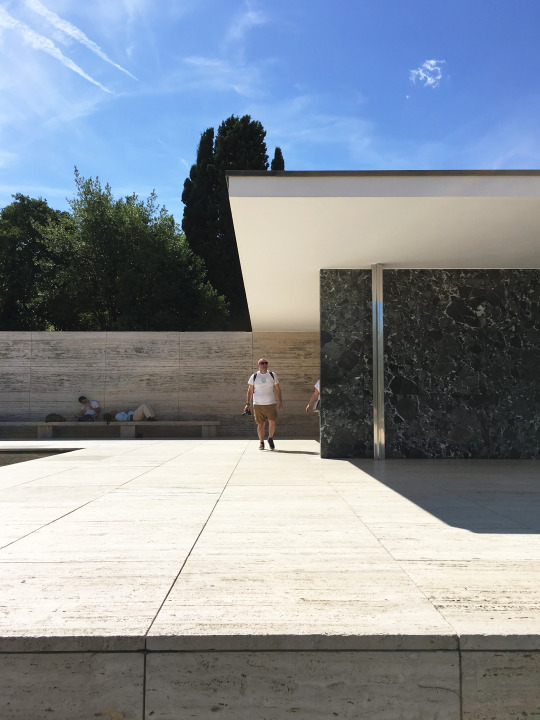
Barcelona Pavilion by Ar. Mies van der Rohe

Ceiling of Sagrada Familia by Ar. Antoni Gaudi
Do you think it’s important to work before taking up master’s study?
I think it depends from person to person. Since I wanted to know more about parametric design, internship felt like an obvious decision to me before diving in. But, I think if you are very clear about what field you want to do Masters in, then you should just go for it.
When did you start with the application process considering the time for application, scholarship/bursary deadlines, etc.?
It was around June 2016 (more than a year before my course started) when I started my application process. I had to prepare all the documents, make my portfolio, resume, Statement of Purpose and Letters of Recommendation. I would say one should start the application process at least 12-18 months before the course starts.
What preparation did you do before starting master’s?
Before going for Masters, I tried to keep my knowledge on computational design constantly updated. I also spoke with an alumni to get a sense of life at IAAC and Barcelona. Before my selection, I had a skype interview. I took this opportunity to ask the admissions officers any doubts I had about the program and the city. I was able to take a firmer decision this way.
Did you have to give any entrance tests? How did you plan for them?
Although the course was taught in English, IAAC didn’t have any language entrance exams. This made the course accessible to bilingual or multilingual students.
How long was your program?
My program was MAA01, which was a ten-month long course. I chose to attend the pre-course offering in September before we officially started in October 2017 and finished in June 2018. The precourse prepped us on Rhino, Adobe After Effects, Premiere Pro and gave us a basic introduction to fabrication techniques.
Did you have post-masters plans in mind when you took up masters? Or did you go with the flow?
No. I just wanted to be in the moment when I was doing the program. Also, I didn’t want to shift my focus from academics and what was happening around me to think about what I would be doing after that.
Did you have to apply for a visa?
The VISA process was a bit tedious for me since there was no Spanish Consulate in my city. But, I was guided a lot by IAAC’s academic personnel. Getting my documents translated into Spanish was another huge task. It was also really hard to find an authorized translator. I ended up finding one in Mumbai.
Once you get to Spain, your visa is valid only for three months. So, you have to apply for a student residency card, which then lets you travel anywhere in Europe. You need to also keep in mind the expiration date of your residency card because mine expired a week after my graduation.
How was the experience at the school?
In two words it was Extremely Intense. I never thought it was going to be so hard. A couple of my classmates even dropped out. I remember during my first semester, I called my mom and told her, I couldn’t do it anymore. Surprisingly, she said okay, which actually gave me the will power to finish the course.
We were a cohort from 60 different countries. It was like being invited to a global multicultural meetup. We celebrated festivals from all the countries, shared cuisines, try to speak each other’s languages. This fraternizing I think, made it a happier and friendlier environment.
The course was ‘taught’ and everything was completely new to me. The fabrication techniques, the studio subjects, the seminars, the electives - all of it. Even the way I thought about architecture changed. I was exposed to how different disciplines co-exist with architecture, and how different tools and machines play a role. Creating architecture from data, for instance, was a mind-boggling experience.

IAAC Family after first semester Digital Fabrication presentation
How was teaching at your school?
I had classes 5 days a week from morning 9am to 6pm for my first semester, the second and third semester I had classes 4 days a week with varied timings. Rather than lectures, each class was more like a discussion. The subjects which required teaching were taught by presentations. They also recorded the lectures, so that even if a student missed something, he/she could see and learn from it later. This also helped students whose primary language was not English.
We had one research studio, two electives, two seminars and one continuous computational design lab. Most of the coursework was divided equally between group work and individual work. We had submissions every single day.
Tell us more about the mentors.
One major break was to not address any faculty as Sir or Ma’am, no matter how senior they were. This small step made it very easy in interacting with them. Apart from being available on email for doubts and such, we also had regular support hours with respective faculty members for two hours a day, so you could meet them personally.
In my second and third term, I was in Self-Sufficient buildings (SSB) studio tutored by my favourite, Enric Ruiz Geli and Mireia Luzarraga. In most architectural schools, the focus is on generating large quantity of presentation sheets, but here, my tutors were asking me to create a single drawing on a lone A1 sheet, which would capture my whole master project. This was my master drawing. The notion that architecture has to be represented in a typical fashion was gone. The master drawing for my proposal was an image output from Processing (a coding language mostly used in the context of visual arts) which showcased the trajectories of bees on my site.

Master Drawing
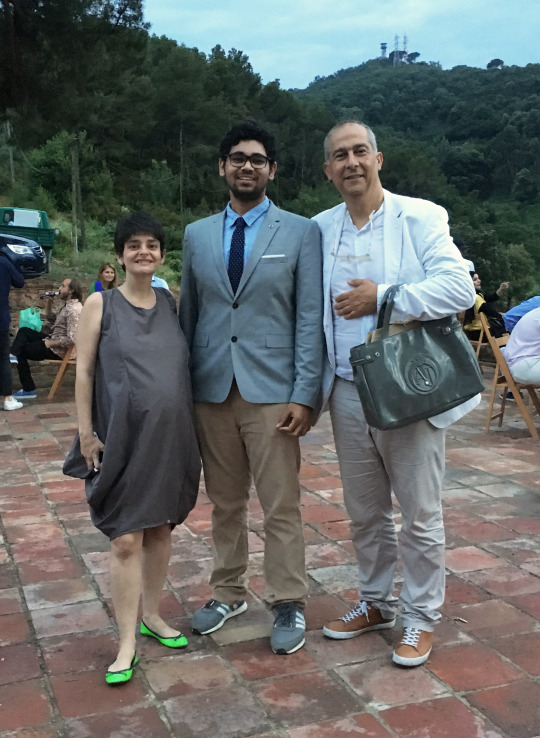
Me, with Mireia and Enric
What kind of support system did your institute/university have in place for international students considering a different learning environment from that of Bachelor’s?
The good thing about IAAC was that people from different disciplines and backgrounds supported and learnt from each other.
Were you involved in research projects/competitions while studying?
I had research electives - one where we researched and designed artefacts for humans in the age of 2050 called ‘Artifacts from the Future’ and another where we found urban fabrics in different cities, which was later compiled into a book titled ‘Urbanisation’.
Could you tell us in brief what your thesis/dissertation/final project was about?
As part of MAA01, I didn’t have a thesis but I had to do a Master Project, which I developed in the Self-Sufficient Buildings studio. We had the studio every Friday from 9:00am to 6:00pm, which included submissions, presentations, personal talks, group discussions planned out over both the terms.
As a class, we chose six blocks of Poblenou in Barcelona to design a co-learning and co-working campus. Each of us chose our own design agendas - mine being Biodiversity. My project was an attempt to increase the biodiversity in these blocks. What started with creating a dataset of different local plants, animals, birds, mammals and other species ended up under a common denominator of pollination. On this site, pollination was carried out by pollinators like bees, ants, hummingbirds, beetles, bats, butterflies etc.
Of these, Bees contributed more than 80% of all crop cultivation. I titled my project ‘(Bee)iodiversity’ with a design aimed at increasing bee population by creating a comfortable and optimum climate for them.

My final presentation material
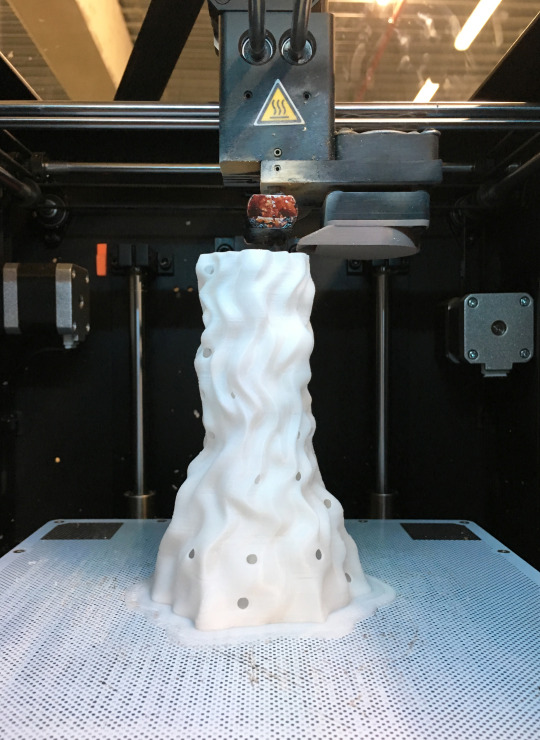
3D printing in action
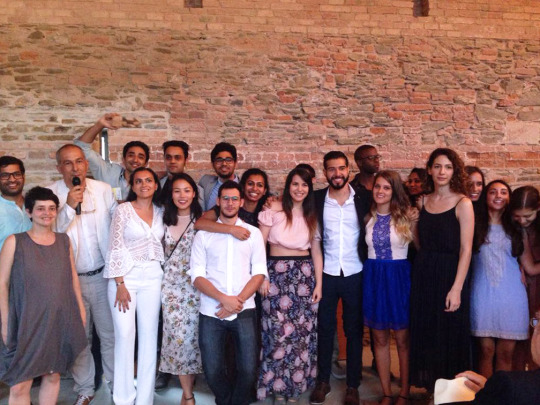
SSB family during graduation
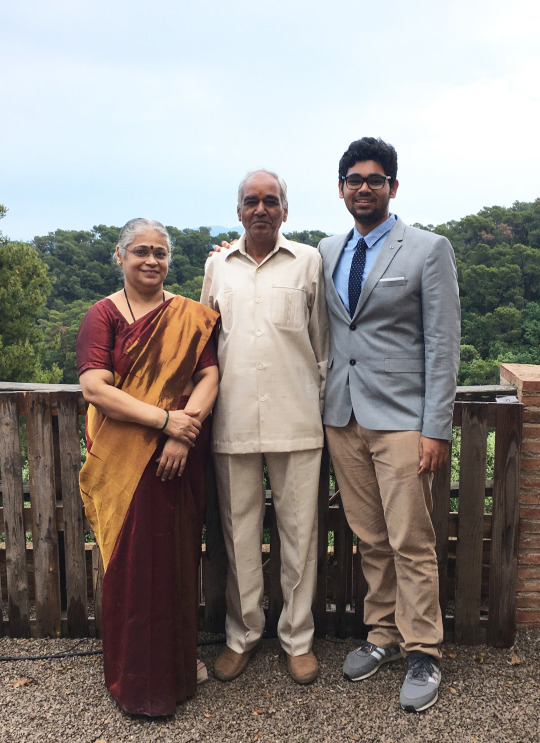
Mom Dad came for my graduation
How did you manage the finances?
All finances were taken care of by my personal family funds and an educational loan.
Did you volunteer/work part-time job/intern while studying?
No. The course was too tightly scheduled to accommodate internships or jobs.
How did you choose your accommodation? Did you have to commute to reach lecture halls?
The first criterion was the cost and the second one was the distance to the campus needed to be walkable. I found two roommates to share an apartment with on IAAC’s online portal for incoming students. Together, we contacted a lot of agencies, AirBnb’s and other students studying in Barcelona. After almost two months of regular search, we found a place and paid them an advance.
Did you travel while/after studying?
I travelled during the two breaks between three semesters. I went to Italy and the United States.
During Christmas 2017, I went to Milan, Italy for five days to visit a friend. It was a relaxed and fun, snow-filled trip. I also visited a ski resort in Sestriere, Lake Como in Lecco and the beautiful stepped streets of Bellagio.

Snow at Sestriere

Perfect reflection at Lake Como

Duomo Di Milano
My next trip was a research trip with my SSB studio for 11 days to USA. This was a hardcore architectural trip.

Beautiful New York skyline at night
We visited New York, Blacksburg, Washington DC and Boston and three universities - Virginia Tech, MIT and Harvard. We actually did a two-day design charrette in Virginia Tech with students from their Masters and senior undergrad students to design a part of their campus. This helped us to exchange design ideas and to see how all of us pursued architecture differently. I also had the fortune of visiting Frank Lloyd Wright’s extraordinary Falling Waters.
You can read more about my travels during Masters on my blog https://medium.com/sliposcopic/welcome-2k19-3aa417555a0d
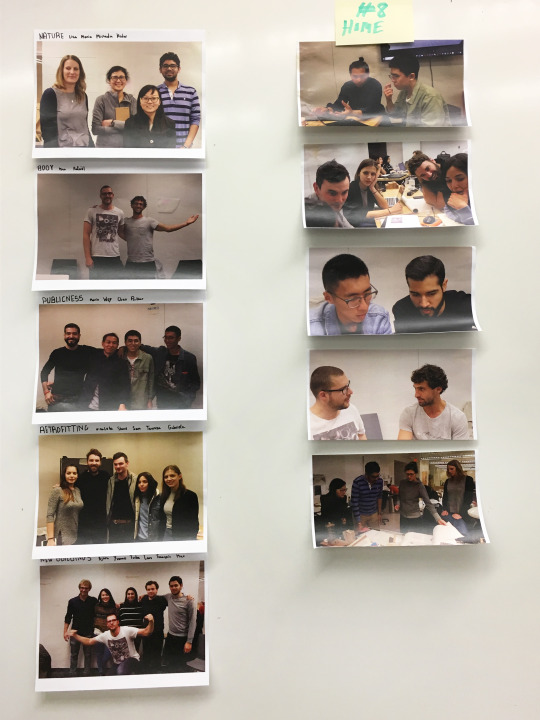
Design Charrette at Virginia Tech

Falling Waters Entrance
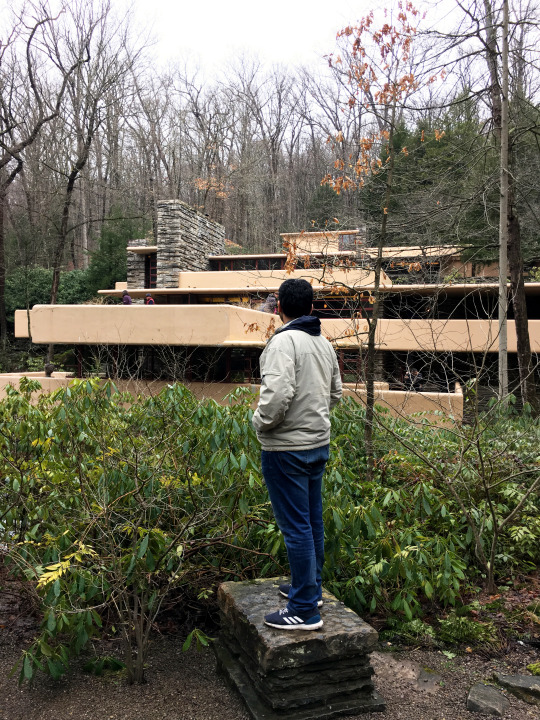
Me bedazzled by Falling Waters
Are there any notable incidents/ anecdotes from post-grad studies that you wish to share?
The trip to the US was a memorable one. We hired two RVs (Recreational Vehicles) in which we lived. Every night, we would pull over to a campground and then sleep in the RV, get ready on the grounds and proceed for the next part of the road trip. Often these campgrounds had semi-covered spaces to hang out and chill.

RV’s chilling in campground

Scale comparison I am 6’ 1” ft

White House and its situation across the street
How do you think doing a master’s degree helped you?
One important lesson was understanding how different professions affect architecture, which is contradictory to how the architectural community around us is - being in our own disciplinary shells. For instance, in my SSB studio every week, we had a guest speaker subject expert. They were lawyers, physicists, sound artists, filmmakers and so on. And, we all discussed our projects with them. Almost always, the feedback from them was what you wouldn’t expect.
Apart from having picked up a new technical skill set; I think the course has made me a better architect overall. I would credit this majorly to being in the Self-Sufficient Buildings studio. It has also made me more empathetic towards nature and shed light on pathways for what design philosophy I should follow.
Did the city/country you studied in play a major role during your postgraduate study?
In my opinion, Yes. I think that the city in which you are studying has to inspire you every day to go out and pursue your dreams. I could not imagine IAAC being anywhere in the world other than Barcelona. I could see how the city was adapting in its architecture to all the technological advancements happening there, which were also central to my program.
Also, being surrounded by innovations such as Barcelona Pavilion, Sagrada Familia, Peix(Fish), Torre Glories, Forum building by Herzog & de Meuron gave me that push I need every week to keep going.

Torre Glories by Ar.Jean Nouvel

Peix by Ar.Frank Gehry
Could you please tell us about your current work and future plans?
I took a break of six months after the program. It was important for me to keep sharpening the skills I had learnt while figuring out the next steps. In February 2019, I decided to start my own practice - Kedar Undale Design Studio in Belgaum, Karnataka where my focus is on creating self-sufficient spaces using computational design and digital fabrication. I am also actively trying to promote the importance, relevance and advantages of employing Computation in Design work through visual art projects, engaging in conversations and so on.
What message would you like to give to students/professionals planning their Post-graduate studies?
I would suggest every undergrad student do a Master’s degree in whichever field or place he/she is interested in. It could open up a whole new side of the field to you. For people who are already in a postgraduate course, I would suggest them to choose focus on their studies over future, have a lot of fun and try to figure out how you can contribute to the field.
Looking back, was there anything you would have done differently?
Travelling more. I did travel during the holidays but, I wish I had travelled even more to places that were nearby during the weekends.
_____________________________________________________________________
About the interviewee…
Kedar is the principal architect of Kedar Undale Design Studio based in Belgaum, Karnataka. His practice mainly focuses on self-sufficient, computationally generated designs with expertise in generative design, parametric design and digital fabrication.
He graduated with a B.Arch degree from KLS Gogte Institute of Technology, Belgaum in 2015 with the seventh rank at the Visvesvaraya Technological University. He completed internships at Collage Architecture Studio, Bangalore and Cadence Architects, Bangalore. Subsequently, he worked at Thirdspace Architecture Studio in Belgaum, as a Junior Architect and was a visiting faculty for Architectural Design and Graphics at KLS GIT’s Dept of Architecture.
You can check out his work at kedarundale.com and contact him at [email protected]
Kedar regularly posts his work in Computational Design on his Instagram page @undalekedar
_____________________________________________________________________
I thank the entire Doodle Dialogue team for inviting me for their interview series. This initiative for sharing first-hand information from graduate students for those aspiring for higher education is a significant one. Kudos to you girls for doing this amazing work!
#Architecture#architecture students#architecturestudent#architecturestudents#@architecture#Architects#m.arch#postgraduation#Post Graduation#postgraduate#higherstudies#barcelona#spain#india#interview#computational design#digital fabrication#master in advanced architecture#institute for advanced architecture of catalonia (iaac)
0 notes
Text
10 Tips for Creating a Winning Architecture Portfolio
The architecture portfolio is the greatest tool in the hands of a student or a professional architect to present themselves and their work to potential employers, clients or tutors. Whether to get architecture jobs with no experience, or want to build up your academic and professional career, there are some golden rules for organizing your work, present your skills and stand out from the crowd in the demanding field of architecture. Always keep in mind that the architecture portfolio is the reflection of your character, your attitude and your view of the world, so just be yourself and follow some simple tips to get the best out of it. Also, check for another strategies to develop your architecture career.

Architecture Portfolio Tips:
1. Listen to the audience
The first question you should ask yourself before starting organizing your architecture portfolio is “who is the audience?”. If you are applying for a position in an architectural firm, do some research online. Try to find out what is the field of their projects (landscape architecture, residence design, internal design) and adjust accordingly. Highlight the projects that are more relevant to theirs and focus on the ones that you think can add a new perspective to the firm. Show them that you have understood completely the role you are supposed to follow but you also have to offer a fresh and innovative point of view on design and architecture.
2. PDF or Online portfolio, Which one is better for you?
Although creating your architecture portfolio on an online template can be much easier and fast, PDF is the option to go. Sometimes servers crash, navigation in the site can be complicated and the recipient can easily become frustrated and move on to another applicant. PDF functions on every device, it can be easily downloaded and you don’t need internet access to read it. Moreover, you have complete control of the appearance and the formatting of your work and also an advantage of promoting your graphic design skills instead of using ready-made templates. Just make sure that your file size is no more than 5MB so that it can be sent with every mail service.
3. Create an appealing CV page
It is usually the first page of your portfolio so it has to make a good first impression. Choose a proper professional photo of yourself and stick only to the relevant and necessary information about your education and work experience. In this era of globalization with companies expanding their projects abroad, knowledge of foreign languages is highly appreciated, so don’t forget to mention them, as well as your computer skills concerning design and architectural programs that you can easily use. Being an architect is a combination of our personality, our gained knowledge through education and experiential processes in our everyday lives. If you are interested in photography, traveling or other hobbies in your free time, try to include them to give an overall view of your character and interests.
4. Select your best projects
Sometimes we fall into the trap of presenting every single project we have ever done, from the first year of architecture school to the last sketch, we made for a friend’s friend. This not only leads to endless portfolios that require valuable time to read but also shows a lack of self-evaluation. Take a moment and select up to 8-10 of your projects that reflect best your work and skills. If you have doubts about a project, its results, or you think it doesn’t suit the firm’s profile, leave it out. In case you want to focus on your evolution through the years, try not go back further than 5 years and make a wise selection as well.
5. Less is more
Keep your portfolio as simple and short as possible. Long presentations and texts tend to exhaust and confuse the reader and distract them from the main purpose: to create a brief image of your personality and skills in a short time. Usually, firms don’t spend more than 1 minute on each portfolio, so make sure that in this time they can get the best out of your work and experience. Give them a general idea of each project, some clues about the design problem, process and final solution, using minimal readable text accompanied with relevant pictures in high quality. The less they need to read to understand your ideas, the better. Instead of analyzing thoroughly every step of the design process, label the images with short comments that show your intentions followed by the visual content.
6. Include team projects, it’s important!\
Although a portfolio is a very personal presentation, it is important to show that you can work as well in teams. We all have participated in projects that require team work and interdisciplinary relationships. Being communicative, flexible and contributing to the team with a specific role given, is a highly appreciated skill in big firms and companies. All you have to do is name the project, give credits to the other partners and focus on the parts of the project that you completed on your own. Whether it is just a technical drawing or a solution to a functional problem, your personal contribution has to be highlighted as a valuable factor.
7. Pay attention to fonts and grammar
The text might be minimal and short but mistakes in spelling and grammar are easily spotted. Always use a spelling and grammar corrector before submitting your portfolio. Your designs and ideas might be great and innovative but a misspelled text looks unprofessional. Try not to overdo it with font styles, or you will lack consistency and order. Choose among 2-3 fonts (Comis Sans is forbidden!) and adjust sizes to emphasize where you need it. Variety is fine as long it does not compromise on clarity and legibility.
8. Use your drawing skills
Using technology in the design process is essential and always required in job positions. Renderings and 3D representations give us an overall view of the final result and a variety of options on materials and surfaces. However, being able to communicate through quick sketches and drawings is still a necessity. So, if you are good at sketching or model making by hand, don’t hesitate to include it in your portfolio. It shows your ability to understand basic concepts and ideas, communicate it to your colleagues in short notice and it also consists a medium of quick problem-solving competence.
9. Don’t be afraid of blank space
The presentation of your work is as much important as the content. Overloaded portfolios with images, texts and renderings are usually doomed to be ignored. It is preferable to have more pages with less content per page than use every inch of your page to fit everything in there. Keep your background clean and don’t use a distractive color that will take the attention from your projects. White or light gray is a good option to go. Try to maintain a consistent format with logical section breaks that will give your images the necessary space to “breathe”. Following a system and geometry throughout your portfolio will give a good impression for you as an architect. Imagine the design of your portfolio as an architectural synthesis: proportions, geometry, aesthetics and function are important factors of the design process. Always think quality, not quantity.
10. Update frequently
The portfolio is a living document and it should be evolving as the architects evolve with every new project and with the challenges they have to face in their professional field. A good option is to update it every six months or at least yearly. Waiting longer tends to allow for work or documentation to go missing. Keep your projects organized and be prepared for every job opportunity that you may come across.
Find more: Architecture Portfolio Examples
0 notes
Text
what are freelance jobs online, freelance guide
If you are interested in gaining more control and freedom in your career, self-employment is an attractive option. freelance jobs guide, jobs online
unsplash.com
Freelance definition
Freelance, freelancer, and freelance worker, are terms frequently. used for a separate who is self-employed and not necessarily committed to a specific employer long-term. Freelance workers are sometimes represented by a corporation or a short-lived agency that resells freelance labor to clients; others work independently or use professional associations or websites to urge work.
what are freelance writing jobs
While the term independent entrepreneur would be used in a special register of English to refer to the tax and employment categories of this type of worker, the term "independent" is most common in the cultural and creative industries, and the use of this term may indicate participation in the bridle.
Freelance fields, professions, and industries:
Web, Mobile & Software Dev :
fields
Ecommerce Development
Scripting & Automation
Mobile Development
Product Management
Game Development
Desktop Software Development
QA & Testing
Web & Mobile Design
Web Development
Other - Software Development
Design & Creative ;
fields
Brand Identity & Strategy
Animation
Presentation Design
Motion Graphics Design
Audio Production
Voice Talent
Physical Design
Graphics & Design
Art & Illustration
Photography
Writing
;
fields
Editing & Proofreading
Content Writing
Ghostwriting
Grant Writing
Writing Tutoring
Career Coaching
Creative Writing
Copywriting
Technical Writing
Business Writing
Sales & Marketing :
fields
Marketing Strategy
Public Relations
Social Media Marketing
Market Research
Email & Marketing Automation
Community Management
Display Advertising
Search Engine Optimization
Telemarketing
Search Engine Marketing
Lead Generation
Admin Support ;
fields
Virtual/Administrative Assistance
Project Management
Order Processing
Data Entry
Transcription
Online Research
Customer Service :
fields
Customer Service
Tech Support
Data Science & Analytics ;
fields
Data Mining
Data Analytics
Data Extraction
Deep Learning
Machine Learning
A/B Testing
Data Engineering
Data Visualization
Data Processing
Knowledge Representation
Experimentation & Testing
Engineering & Architecture ;
fields
Civil & Structural Engineering
Architecture
Mechanical Engineering
Electrical Engineering
Sourcing & Procurement
D Modeling & CAD
Interior Design
Chemical Engineering
Product Design
Other - Engineering & Architecture
Benefits Freelance
Freelancers have a variety of reasons for free-lancing; perceived benefits differ by gender, industry, and lifestyle. For example, the 2012 Independent Industry Report indicated that independent men and women were independent men and women for a variety of reasons. The women interviewed indicated that they preferred the freedom and flexibility of the programming offered by freelancers, while the men interviewed indicated that they were independent to follow or pursue their personal passions.
freelance meaning
Freelance also allows people to achieve higher levels of employment in isolated communities. Another advantage is the ability to choose who the freelancer works with. The freelancer interviews a potential client and may choose whether or not to work with that person or company.freelance yoga jobs
Freelance is also carried out by laid-off workers, who cannot find full-time employment, or for sectors such as journalism that are increasingly dependent on agency workers rather than full-time staff. Freelancers are also made up of students who try to make ends meet during the semester. In interviews and on independent blogs, freelancers list choice and flexibility as an advantage.
Drawbacks Freelance
Freelance, like other forms of casual work, can be precarious work. Websites, books, portals, and organizations for freelancers often offer advice on getting and maintaining a steady workflow. In addition to the lack of job security, many freelancers also report the ongoing hassle of dealing with employers who do not pay on time and the possibility of long periods of time without work. In addition, freelancers do not receive employment benefits such as pension, sick leave, paid leave, premiums, or health insurance, which can be a serious challenge for freelancers residing in countries like the United States without universal health care.
freelance or agency
Freelancers often earn less than their employed counterparts, although sometimes the opposite is true. Although most freelancers have at least 10 years of experience before working independently, experienced freelancers do not always earn an income equal to that of a full-time job. Members' comments suggest that web portals such as Freelancer.com tend to attract low-paying customers who, while requiring very high standards, pay $10 per hour or less. Low-cost suppliers often offer to work at rates as low as $1 to $2 an hour. Since most projects require tenders, professionals will not bid because they refuse to work at such rates. This has the effect of reducing the overall quality of the services provided.
The11 Best Websites for Learning New Skills
In all areas Diverse Learning, Coaching, Languages, Life Lessons, Online Training, and more...
coursera
edx
udemy
coach
The Muse
Babbel
duolingo
codecademy
Udacity
lynda
thinkful
Best Freelance Websites 2020
You can work directly through these sites
Fiverr
Guru
Freelancer
Upwork
PeoplePerHour
8 Best Freelance Jobs Websites to Get Remote Freelance Work in 2020
Kelly Services
Real Staffing
Onward Search
Dahl Consulting
Ajilon
Computer FutureS
Paladin Staffing
Addison Group
------------------------------------------------------
Suggested ARTICLES ;
What Experience Do I Need to Work From Home For Amazon?
Amazon Work From Home Jobs
What You’ll Be Doing,Customer Service Rep
Where Does Amazon Hire?Work From Home For Amazon
What About Technical Requirements? What Will I Need?
How Much Will I Make?Work From Home For Amazon?
Best Legitimate Work-From-Home Jobs We’ve Found in 2020
----------------------------------------------------
0 notes
Text
How Technology is Changing the Future of Higher Education
This article is part of our latest Learning special report. We’re focusing on Generation Z, which is facing challenges from changing curriculums and new technology to financial aid gaps and homelessness.
MANCHESTER, N.H. — Cruising to class in her driverless car, a student crams from notes projected on the inside of the windshield while she gestures with her hands to shape a 3-D holographic model of her architecture project.
It looks like science fiction, an impression reinforced by the fact that it is being demonstrated in virtual reality in an ultramodern space with overstuffed pillows for seats. But this scenario is based on technology already in development.
The setting is the Sandbox ColLABorative, the innovation arm of Southern New Hampshire University, on the fifth floor of a downtown building with panoramic views of the sprawling red brick mills that date from this city’s 19th-century industrial heyday.
It is one of a small but growing number of places where experts are testing new ideas that will shape the future of a college education, using everything from blockchain networks to computer simulations to artificial intelligence, or A.I.
Theirs is not a future of falling enrollment, financial challenges and closing campuses. It’s a brighter world in which students subscribe to rather than enroll in college, learn languages in virtual reality foreign streetscapes with avatars for conversation partners, have their questions answered day or night by A.I. teaching assistants and control their own digital transcripts that record every life achievement.
The possibilities for advances such as these are vast. The structure of higher education as it is still largely practiced in America is as old as those Manchester mills, based on a calendar that dates from a time when students had to go home to help with the harvest, and divided into academic disciplines on physical campuses for 18- to 24-year-olds.
Universities may be at the cutting edge of research into almost every other field, said Gordon Jones, founding dean of the Boise State University College of Innovation and Design. But when it comes to reconsidering the structure of their own, he said, “they’ve been very risk-averse.”
Now, however, squeezed by the demands of employers and students — especially the up and coming Generation Z — and the need to attract new customers, some schools, such as Boise State and Southern New Hampshire University, are starting labs to come up with improvements to help people learn more effectively, match their skills with jobs and lower their costs.
College by Subscription
One of these would transform the way students pay for higher education. Instead of enrolling, for example, they might subscribe to college; for a monthly fee, they could take whatever courses they want, when they want, with long-term access to advising and career help.
The Georgia Institute of Technology is one of the places mulling a subscription model, said Richard DeMillo, director of its Center for 21st Century Universities. It would include access to a worldwide network of mentors and advisers and “whatever someone needs to do to improve their professional situation or acquire a new skill or get feedback on how things are going.”
Boise State is already piloting this concept. Its Passport to Education costs $425 a month for six credit hours or $525 for nine in either of two online bachelor’s degree programs. That’s 30 percent cheaper than the in-state, in-person tuition.
Paying by the month encourages students to move faster through their educations, and most are projected to graduate in 18 months, Mr. Jones said. The subscription model has attracted 47 students so far, he said, with another 94 in the application process.
However they pay for it, future students could find other drastic changes in the way their educations are delivered.
Your Teacher Is a Robot
Georgia Tech has been experimenting with a virtual teaching assistant named Jill Watson, built on the Jeopardy-winning IBM Watson supercomputer platform. This A.I. answers questions in a discussion forum alongside human teaching assistants; students often can’t distinguish among them, their professor says. More Jill Watsons could help students get over hurdles they encounter in large or online courses. The university is working next on developing virtual tutors, which it says could be viable in two to five years.
S.N.H.U., in a collaboration with the education company Pearson, is testing A.I. grading. Barnes & Noble Education already has an A.I. writing tool called bartleby write, named for the clerk in the Herman Melville short story, that corrects grammar, punctuation and spelling, searches for plagiarism and helps create citations.
At Arizona State University, A.I. is being used to watch for signs that A.S.U. Online students might be struggling, and to alert their academic advisers.
“If we could catch early signals, we could go to them much earlier and say, ‘Hey you’re still in the window’ ” to pass, said Donna Kidwell, chief technology officer of the university’s digital teaching and learning lab, EdPlus.
Another harbinger of things to come sits on a hillside near the Hudson River in upstate New York, where an immersion lab with 15-foot walls and a 360-degree projection system transports Rensselaer Polytechnic Institute language students to China, virtually.
The students learn Mandarin Chinese by conversing with A.I. avatars that can recognize not only what they say but their gestures and expressions, all against a computer-generated backdrop of Chinese street markets, restaurants and other scenes.
Julian Wong, a mechanical engineering major in the first group of students to go through the program, “thought it would be cheesy.” In fact, he said, “It’s definitely more engaging, because you’re actively involved with what’s going on.”
Students in the immersion lab mastered Mandarin about twice as fast as their counterparts in conventional classrooms, said Shirley Ann Jackson, the president of Rensselaer.
Dr. Jackson, a physicist, was not surprised. The students enrolling in college now “grew up in a digital environment,” she said. “Why not use that to actually engage them?”
Slightly less sophisticated simulations are being used in schools of education, where trainee teachers practice coping with simulated schoolchildren. Engineering students at the University of Michigan use an augmented-reality track to test autonomous vehicles in simulated traffic.
A Transcript for Life
The way these kinds of learning get documented is also about to change. A race is underway to create a lifelong transcript.
Most academic transcripts omit work or military histories, internships, apprenticeships and other relevant experience. And course names such as Biology 301 or Business 102 reveal little about what students have actually learned.
“The learner, the learning provider and the employer all are speaking different languages that don’t interconnect,” said Michelle Weise, chief innovation officer at the Strada Institute for the Future of Work.
A proposed solution: the “interoperable learning record,” or I.L.R. (proof that, even in the future, higher education will be rife with acronyms and jargon).
The I.L.R. would list the specific skills that people have learned — customer service, say, or project management — as opposed to which courses they passed and majors they declared. And it would include other life experiences they accumulated.
This “digital trail” would remain in the learner’s control to share with prospective employers and make it easier for a student to transfer academic credits earned at one institution to another.
American universities, colleges and work force training programs are now awarding at least 738,428 unique credentials, according to a September analysis by a nonprofit organization called Credential Engine, which has taken on the task of translating these into a standardized registry of skills.
Unlike transcripts, I.L.R.s could work in two directions. Not only could prospective employees use them to look for jobs requiring the skills they have; employers could comb through them to find prospective hires with the skills they need.
“We’re trying to live inside this whole preindustrial design and figure out how we interface with technology to take it further,” said Ms. Kidwell of Arizona State. “Everybody is wrangling with trying to figure out which of these experiments are really going to work.”
This story was produced in collaboration with The Hechinger Report, a nonprofit, independent news organization focused on inequality and innovation in education.
from WordPress https://mastcomm.com/tech/how-technology-is-changing-the-future-of-higher-education/
0 notes
Text
10 Tips for Creating a Winning Architecture Portfolio
The architecture portfolio is the greatest tool in the hands of a student or a professional architect to present themselves and their work to potential employers, clients or tutors. Whether to get architecture jobs with no experience or want to build up your academic and professional career, there are some golden rules for organizing your work, present your skills and stand out from the crowd in the demanding field of architecture. Always keep in mind that the architecture portfolio is the reflection of your character, your attitude and your view of the world, so just be yourself and follow some simple tips to get the best out of it. Also, check for another strategy to develop your architecture career.
Architecture Portfolio Tips:
1. Listen to the audience
The first question you should ask yourself before starting organizing your architecture portfolio is “who is the audience?”. If you are applying for a position in an architectural firm, do some research online. Try to find out what is the field of their projects (landscape architecture, residence design, internal design) and adjust accordingly. Highlight the projects that are more relevant to theirs and focus on the ones that you think can add a new perspective to the firm. Show them that you have understood completely the role you are supposed to follow but you also have to offer a fresh and innovative point of view on design and architecture.
2. PDF or Online portfolio, Which one is better for you?
Although creating your architecture portfolio on an online template can be much easier and fast, PDF is the option to go. Sometimes servers crash, navigation in the site can be complicated and the recipient can easily become frustrated and move on to another applicant. PDF functions on every device, it can be easily downloaded and you don’t need internet access to read it. Moreover, you have complete control of the appearance and the formatting of your work and also an advantage of promoting your graphic design skills instead of using ready-made templates. Just make sure that your file size is no more than 5MB so that it can be sent with every mail service.
3. Create an appealing CV page
It is usually the first page of your portfolio so it has to make a good first impression. Choose a proper professional photo of yourself and stick only to the relevant and necessary information about your education and work experience. In this era of globalization with companies expanding their projects abroad, knowledge of foreign languages is highly appreciated, so don’t forget to mention them, as well as your computer skills concerning design and architectural programs that you can easily use. Being an architect is a combination of our personality, our gained knowledge through education and experiential processes in our everyday lives. If you are interested in photography, traveling or other hobbies in your free time, try to include them to give an overall view of your character and interests.
4. Select your best projects
Sometimes we fall into the trap of presenting every single project we have ever done, from the first year of architecture school to the last sketch, we made for a friend’s friend. This not only leads to endless portfolios that require valuable time to read but also shows a lack of self-evaluation. Take a moment and select up to 8-10 of your projects that reflect best your work and skills. If you have doubts about a project, its results, or you think it doesn’t suit the firm’s profile, leave it out. In case you want to focus on your evolution through the years, try not go back further than 5 years and make a wise selection as well.
5. Less is more
Keep your portfolio as simple and short as possible. Long presentations and texts tend to exhaust and confuse the reader and distract them from the main purpose: to create a brief image of your personality and skills in a short time. Usually, firms don’t spend more than 1 minute on each portfolio, so make sure that in this time they can get the best out of your work and experience. Give them a general idea of each project, some clues about the design problem, process and final solution, using minimal readable text accompanied with relevant pictures in high quality. The less they need to read to understand your ideas, the better. Instead of analyzing thoroughly every step of the design process, label the images with short comments that show your intentions followed by the visual content.
6. Include team projects, it’s important!
Although a portfolio is a very personal presentation, it is important to show that you can work as well in teams. We all have participated in projects that require team work and interdisciplinary relationships. Being communicative, flexible and contributing to the team with a specific role given, is a highly appreciated skill in big firms and companies. All you have to do is name the project, give credits to the other partners and focus on the parts of the project that you completed on your own. Whether it is just a technical drawing or a solution to a functional problem, your personal contribution has to be highlighted as a valuable factor.
7. Pay attention to fonts and grammar
The text might be minimal and short but mistakes in spelling and grammar are easily spotted. Always use a spelling and grammar corrector before submitting your portfolio. Your designs and ideas might be great and innovative but a misspelled text looks unprofessional. Try not to overdo it with font styles, or you will lack consistency and order. Choose among 2-3 fonts (Comis Sans is forbidden!) and adjust sizes to emphasize where you need it. Variety is fine as long it does not compromise on clarity and legibility.
8. Use your drawing skills
Using technology in the design process is essential and always required in job positions. Renderings and 3D representations give us an overall view of the final result and a variety of options on materials and surfaces. However, being able to communicate through quick sketches and drawings is still a necessity. So, if you are good at sketching or model making by hand, don’t hesitate to include it in your portfolio. It shows your ability to understand basic concepts and ideas, communicate it to your colleagues in short notice and it also consists a medium of quick problem-solving competence.
9. Don’t be afraid of blank space
The presentation of your work is as much important as the content. Overloaded portfolios with images, texts and renderings are usually doomed to be ignored. It is preferable to have more pages with less content per page than use every inch of your page to fit everything in there. Keep your background clean and don’t use a distractive color that will take the attention from your projects. White or light gray is a good option to go. Try to maintain a consistent format with logical section breaks that will give your images the necessary space to “breathe”. Following a system and geometry throughout your portfolio will give a good impression for you as an architect. Imagine the design of your portfolio as an architectural synthesis: proportions, geometry, aesthetics and function are important factors of the design process. Always think quality, not quantity.
10. Update frequently
The portfolio is a living document and it should be evolving as the architects evolve with every new project and with the challenges they have to face in their professional field. A good option is to update it every six months or at least yearly. Waiting longer tends to allow for work or documentation to go missing. Keep your projects organized and be prepared for every job opportunity that you may come across.
0 notes
Text
How Cash-Strapped Co-Parents Can Bring in Extra Money with a Side Gig
There are approximately 13.7 million single parents raising 22 million children in the United States, and while 76 percent of mothers and 85.1 percent of fathers are working, sometimes one job isn’t enough to make ends meet.
If this sounds like your situation, the good news is that thanks to a rise in jobs within the gig economy, you no longer have to sacrifice all your valuable family time in an effort to bring in more cash. Benefits for single parents include flexibility, decent wages, and the possibility of working from home.
Here’s how to get started holding down a lucrative side gig without renouncing your most important role: being a mom or dad.
Getting Started
The first thing you should do is figure out how much extra money you want to bring in so you can determine how many hours and/or what type of work you should consider. When establishing your budget, keep in mind that the majority of gigs are feast or famine, so you have to factor in dry spells. You’ll also want to set money aside for taxes since they won’t be taken out if you work as an independent contractor or if you decide to start your own business.
To help you stay organized, designate a distraction-free area in your home as an office space that’s outfitted with updated and working technology, an ergonomically designed chair, and ample lighting. Incorporate stress-busting elements such as plants, photos, or artwork that bring you pleasure; aesthetically pleasing window treatments; and furnishings such as a comfortable chair with a reading lamp where you can take a break. Speaking of which, make sure you take regular breathers and establish set office hours so your kids know when to leave you alone.
Gig Ideas
There are many online resources and apps where you can look for gig-related work, but first you have to determine if you want to do something you love, you know, or a combination of both. If you happen to already be in the fields of artificial intelligence, blockchain architecture, robotics, ethical hacking, cryptocurrency, or virtual reality, you’re in luck, as these jobs are among the highest paying in the gig economy — but don’t be discouraged otherwise. There are plenty of other lucrative opportunities in the following areas:
fitness training and coaching
consulting
writing
tutoring
tax preparation
graphic design
pet sitting
reselling items online (or making something from scratch)
computer repair
direct sales
Building Your Business
To truly thrive, you’re going to need to put a little effort into building your business, whether that means identifying with a specific social media channel, taking out a small ad, attending a targeted conference, updating your equipment, or improving your product. Just be sure to establish a clear budget to prevent winding up in the hole — being conservative about your spending habits doesn’t mean you’ll be any less successful.
When setting a budget, it’s very important to separate your business expenses from your personal finances. One way to do this is by opening a business credit card, which will allow you to separately track all of your business spending. However, before selecting one, be sure to research available options so that you can find the business credit card that best suits your needs.
It can be difficult for kids of single parents to understand why mom and dad have to work so much, so make sure you establish an open dialogue with your children. Focus on the positive aspects of your work instead of the negative. For example, instead of saying you need more money to put food on the table, spin it as you want to make sure they have everything they need. There’s no need to display a pie chart detailing your family’s financial situation, but the sooner you teach them about the value of a dollar, the easier it will be for them to understand your work schedule.
About the Author: After being in a car accident, Caleb Anderson developed an opiate addiction, for which he received treatment. He is in recovery today and has started RecoveryHope.org with his wife Molly. They now provide resources and support to other couples and individuals to help them face the challenges of drug and alcohol addictions.
The post How Cash-Strapped Co-Parents Can Bring in Extra Money with a Side Gig appeared first on Wevorce.
How Cash-Strapped Co-Parents Can Bring in Extra Money with a Side Gig published first on https://divorcelawyermumbai.tumblr.com/
0 notes